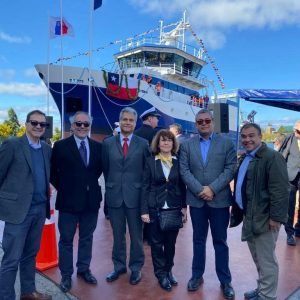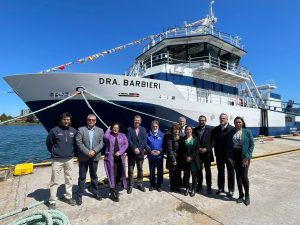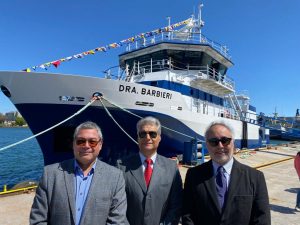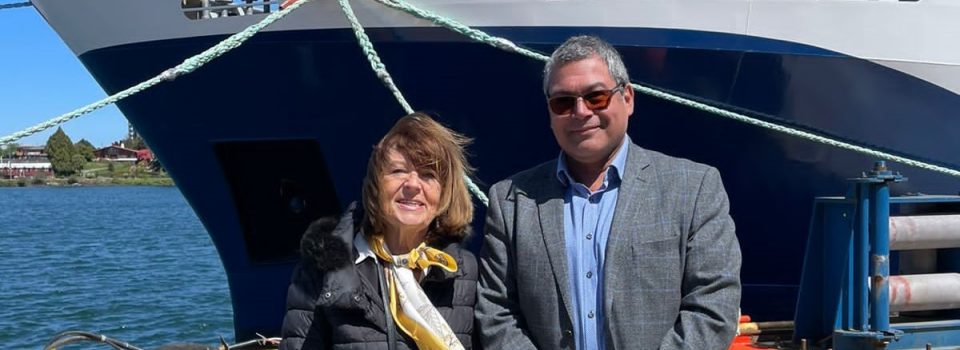New Dra. Barbieri Research Vessel will be operated by IFOP
October 23rd, 2023 It is a Silent Boat (ICES 209 standard, Silent-R) to not disturb fish’s behavior when prospected, avoiding escape when the boat passes, improving biomass estimates.
It is a Silent Boat (ICES 209 standard, Silent-R) to not disturb fish’s behavior when prospected, avoiding escape when the boat passes, improving biomass estimates.
On October 12th, at ASENAV shipyard in Valdivia, fishing and oceanographic research vessel Dra. Barbieri’s baptism and launch took place, a project financed by Fisheries and Aquaculture Undersecretariat, and which will be operated by Fishing Development Institute.
 Various national and regional authorities participated in the ceremony, including of Fisheries Undersecretariat, Julio Salas; Los Ríos’s governor, Luis Cuvertino; Regional presidential delegate, Carla Peña; IFOP director, Gonzalo Pereira, who referred to the ship “as IFOP, we are very happy and proud to be responsible for this new research vessel Dra. Barbieri’s operation, together with Abate Molina scientific vessel, will allow us to expand investigations carried out in sectors in which Abate Molina cannot reach due to its size. We are very happy that this ship has Dr. Barbieri’s name, in tribute to an outstanding professional who developed a large part of her performance in our institution. María Ángela Barbieri was a pioneer in developing and progressing in the hydroacoustic evaluation studies that are carried out. On the other hand, I have to highlight and thank IFOP’s officials who worked on the ship’s construction technical support, there were several teams that participated, I want to highlight Jorge Castillo and Patricio Herrera who were there from the first minute making their technicial contribution for its construction.”
Various national and regional authorities participated in the ceremony, including of Fisheries Undersecretariat, Julio Salas; Los Ríos’s governor, Luis Cuvertino; Regional presidential delegate, Carla Peña; IFOP director, Gonzalo Pereira, who referred to the ship “as IFOP, we are very happy and proud to be responsible for this new research vessel Dra. Barbieri’s operation, together with Abate Molina scientific vessel, will allow us to expand investigations carried out in sectors in which Abate Molina cannot reach due to its size. We are very happy that this ship has Dr. Barbieri’s name, in tribute to an outstanding professional who developed a large part of her performance in our institution. María Ángela Barbieri was a pioneer in developing and progressing in the hydroacoustic evaluation studies that are carried out. On the other hand, I have to highlight and thank IFOP’s officials who worked on the ship’s construction technical support, there were several teams that participated, I want to highlight Jorge Castillo and Patricio Herrera who were there from the first minute making their technicial contribution for its construction.”
 It has the capacity to easily accommodate 8 scientists and 11 crew members. Its area and operating regime will be Arica to Chacao Channel and inland waters coastal sector from Chacao Channel to Golfo de Penas. This ship will be able to operate for 24 hours, will have a 10 day’s autonomy without resupply and an operating radius of 500 nautical miles.
It has the capacity to easily accommodate 8 scientists and 11 crew members. Its area and operating regime will be Arica to Chacao Channel and inland waters coastal sector from Chacao Channel to Golfo de Penas. This ship will be able to operate for 24 hours, will have a 10 day’s autonomy without resupply and an operating radius of 500 nautical miles.
It’s mission will be:
- Pelagic fish biomass evaluation (sardine-anchovy) in Los Lagos Aysén and Magallanes coastal sectors and inland waters using acoustic methods
- Demersal crustaceans biomass evaluation (prawns and shrimp) between Coquimbo and Biobío using fishing nets.
- Fish populations biological prospected sampling through reconnaissance fishing with pelagic nets (mediagua).
- Seabed bathymetric survey
- Physical, biological oceanography and meteorology climatic change research and El Niño Phenomenon, through Plankton sampling and study (ichthium, zoo and phyto-plankton),
- temperature vertical physical conditions, salinity, oxygen, fluorine, sea acidity,
- Horizontal profile in temperature navigation,sea’s salinity, oxygen, fluoride and acidity.
- Meteorological data in navigation.
- Correntometry, (study of sea currents)
The ship has:
- Acoustic and data processing laboratory, for scientific echo sounders operation. With computers and 27-inch KVM screens, LAN network and computer server.
- Dry laboratory for data processing with 2 workstations with computers and KVM screens and LAN network, from here the oceanographic rosette and the oceanographic winch are controlled
- Wet laboratory to process water samples, with LAN network, a vacuum pump for chlorophyll extraction, 2 scientific-level freezers for sample maintenance.
- Fish measurements (size, weighing) laboratory for obtaining biological samples for stocks characterization, stainless steel counters, with electronic scales with compensated movement and ichthyometers for measuring individuals size all connected to a central computer.
Press related links:
